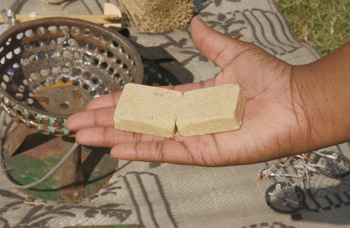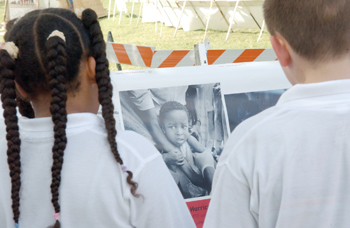
A visitor to the mock refugee camp holds BP-5 Compact Emergency Food, a high-protein biscuit that refugees receive in emergency situations. International standards call for each refugee to receive eight BP-5 biscuits each day.
Photo by Susan Urmy
Exhibit gives feel for refugees’ plight

East Academy Magnet School students Cheyenne Rainey and Colbe Craven, look at photographs from a real refugee camp at the event.
Photo by Susan Urmy
Students from the Vanderbilt University School of Nursing, Meharry-Vanderbilt Student Alliance and elsewhere learned what it's like to live in a refugee camp when they visited the Doctors without Borders/Mèdecins Sans Frontiéres (MSF) Refugee Camp in the Heart of the City exhibit last week in Centennial Park.
The international humanitarian organization developed the interactive exhibit to demonstrate the plight of refugees and internationally displaced persons worldwide who have been forced to flee their homes to seek refuge from conflict and persecution.
Carol Etherington, M.S.N., R.N., former MSF USA president and assistant professor of Nursing at VUSN, was instrumental in bringing the camp to Nashville.
“This exhibit is one of the most dramatic ways to educate people about the lives of people they see on the 6 o'clock news,” said Etherington.
MSF reports that 33 million people are currently displaced from their homes in more than 60 countries. Nashville has felt the impact of this as well, with more than 9,000 refugees from 40 countries living in the area.
More than 4,000 Middle Tennesseans toured the camp, stepping into a world where the basic necessities of life — such as food, water and shelter — are the difference between life and death.
Students took an hour-long tour that started with a crossing gate to signify the feeling of crossing an international border.
They then toured typical shelters made up of tents and wooden shacks, learned about food rations, water rations and how hygiene issues are handled. The tour included actual items created by refugees.
One tour guide explained that refugees reuse everything possible in the camp setting and illustrated this point with examples of sandals made from tire treads, stoves made from empty cans and intricate children's toys skillfully formed from tin lids and wire.
Meharry-Vanderbilt Student Alliance medical and nursing students toured the exhibit and participated in a special question-and-answer session. Students were impressed with the tour guides, each of whom had served in various refugee field capacities and who were very open about their personal experiences.
VUSN's community health students were particularly interested in how humanitarian workers deal with cholera outbreaks, vaccinations, child birth and emotional support for the refugees.
Megan Cashian, a VUSN/Lipscomb nursing student who has previously worked on medical mission trips in Peru and Mexico, admits she hasn't experienced this level of poverty before.
“We take a lot of classes looking at hospital-based patients,” said Cashian. “Visiting the camp is very interesting and allows us to step outside the box and look at things from different perspectives.”
VUSN faculty members Sharon Jones, M.S.N., R.N., and Marty Conrad, M.P.H., R.N., viewed the refugee camp as a great opportunity for their students.
“It's important for nurses to get cultural education and sensitivity,” said Conrad. “They will work with refugee populations in their careers in hospitals and other settings, and understanding the entire adjustment process will help them be better nurses.”













